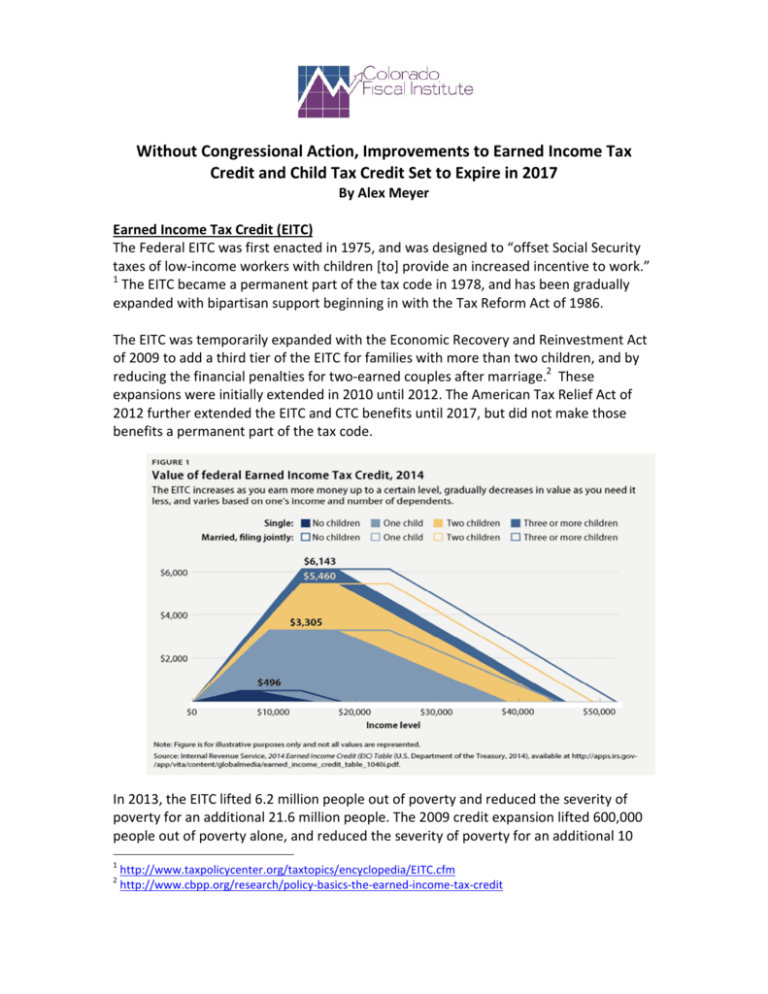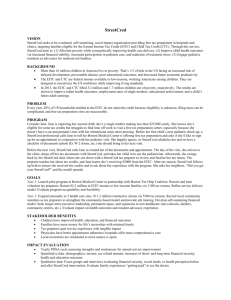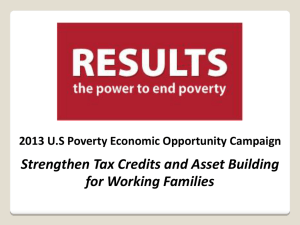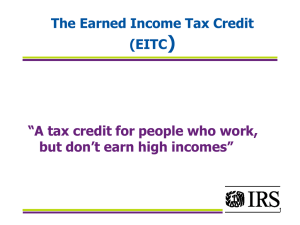Without Congressional Action, Improvements to Earned Income Tax
advertisement

Without Congressional Action, Improvements to Earned Income Tax Credit and Child Tax Credit Set to Expire in 2017 By Alex Meyer Earned Income Tax Credit (EITC) The Federal EITC was first enacted in 1975, and was designed to “offset Social Security taxes of low-income workers with children [to] provide an increased incentive to work.” 1 The EITC became a permanent part of the tax code in 1978, and has been gradually expanded with bipartisan support beginning in with the Tax Reform Act of 1986. The EITC was temporarily expanded with the Economic Recovery and Reinvestment Act of 2009 to add a third tier of the EITC for families with more than two children, and by reducing the financial penalties for two-earned couples after marriage.2 These expansions were initially extended in 2010 until 2012. The American Tax Relief Act of 2012 further extended the EITC and CTC benefits until 2017, but did not make those benefits a permanent part of the tax code. In 2013, the EITC lifted 6.2 million people out of poverty and reduced the severity of poverty for an additional 21.6 million people. The 2009 credit expansion lifted 600,000 people out of poverty alone, and reduced the severity of poverty for an additional 10 1 2 http://www.taxpolicycenter.org/taxtopics/encyclopedia/EITC.cfm http://www.cbpp.org/research/policy-basics-the-earned-income-tax-credit million.3 The average amount of credit each family received nationwide was $2,411 in 2013. Child Tax Credit (CTC) The Federal CTC was first enacted in 1997 with bipartisan support. The nonrefundable credit was designed to alleviate the tax burden of families, as the tax code at the time did not accurately “reflect a family’s reduced ability to pay taxes as family size increases.”4 The CTC is not only targeted at lower income families, but applies to middle income families as well. The 2009 Economic Recovery Act adjusted CTC parameters to making more “workingpoor families eligible for the CTC” by lowering the minimum family earnings to $3,000 dollars to qualify.5 This improvement was extended until the end of 2017 with the Taxpayer Relief Act of 2012. 3 Ibid. http://www.epi.org/publication/ib370-earned-income-tax-credit-and-the-child-tax-credit-historypurpose-goals-and-effectiveness/ 5 http://www.cbpp.org/blog/without-extending-key-2009-improvement-indexing-child-tax-credit-leavesout-many-families 4 Timeline of EITC/CTC Legislation 1975 – EITC is introduced into tax code for the 1975 calendar year as a method of poverty alleviation. 1978 – EITC becomes a permanent part of the tax code in Revenue Act of 1978. 1986-7 – EITC is expanded and indexed to inflation with bipartisan support in the Tax Reform act of 1986, becoming one of the primary methods of combatting poverty. 1990, 1993 – EITC benefits are expanded further. 1997 – Child Tax Credit is enacted with bipartisan support. 2001 – Bush tax cuts, EITC and CTC are expanded once again. The EITC is changed to provide marriage penalty relief and the CTC is doubled from $500 to $1,000 per child. 2009 – Economic Recovery Act temporarily expands tax credits (see EITC/CTC) 2012 – American Taxpayer Relief Act extends the EITC expansion until the end of 2017. 2013-2015 – Legislative attempts to make the EITC and CTC permanent and expand benefits fail. 2017 – EITC and CTC expansions set to expire. Recent Legislation Working Families Tax Relief Act (Brown, Durbin, Neal, DeLauro): “The Working Families Tax Relief Act would expand and extend the Earned Income Tax Credit (EITC) and the Child Tax Credit (CTC). In addition to making the 2009 expansion of both tax credits permanent, the bill would expand EITC for workers without children, index the CTC to inflation, and make it easier for working Americans who qualify to claim the EITC.”6 Latest Actions: April 20th – bill introduced and referred to the Senate Committee on Finance. 2016 Congressional Budget Resolution: “[The resolution] includes about $160 billion in cuts from allowing tax credits for lowand modest-income working families to expire. The budget plan allows critical provisions of the Earned Income Tax Credit (EITC) and the Child Tax Credit (CTC) that were enacted in 2009 to expire at the end of 2017. This would cause more than 16 6 http://democrats.waysandmeans.house.gov/press-release/senate-and-house-democrats-introduce-billsput-more-money-pockets-working-families million people in low-income working families, including 8 million children, to fall into — or deeper into — poverty.”7 Latest Actions: May 5 - Congressional Republicans adopted this concurrent budget resolution in May, setting a framework for the appropriations process. President’s Budget – Fiscal Year 2016: “[The budget] proposes to expand the Earned Income Tax Credit (EITC) for workers without children and non-custodial parents, promoting employment while reducing poverty and hardship for 13.2 million low-income workers struggling to make ends meet. In addition, the Budget continues to propose making permanent improvements to the EITC and Child Tax Credit that augment wages for 16 million families with 29 million children each year but are scheduled to expire at the end of 2017. Allowing these benefits to expire would result in a roughly $1,700 tax increase for a full-time minimum wage worker with two children.”8 Latest Actions: February 2nd – proposed by the President for congressional review. 7 http://www.cbpp.org/research/federal-budget/the-congressional-2016-budget-plan-an-alarmingvision#_ftn7 8 https://www.whitehouse.gov/omb/budget National Consequences Without Extension Should the expansions upon the EITC and CTC expire in 2017, 1.6 million people (including 1 million children) would drop into poverty while an additional 14.6 million (including 6.7 million children) would fall deeper into poverty.9 For 13 million families, including 25 million children, benefits would be cut an average of $1,073.10 Even if these expansions were to be made permanent in any of these bills, the current composition of the EITC would not sufficiently cover childless workers. Currently, childless workers under the age of 25 do not qualify for EITC benefits. The president’s budget proposal for fiscal year 2016, one of several such proposals to reform the EITC, would lift an additional 500,000 people out of poverty, and relieve the poverty of an additional 10.1 million.11 In addition, should the CTC improvements remain temporary, the minimum qualifying family income to receive partial CTC benefits will raise to $14,500 a year, while the minimum to receive the maximum amount will raise to $28,050 a year.12 This would be disastrous for those families with the lowest incomes. Colorado State Tax Context In 1999, Colorado passed a state EITC that was set at 10 percent of the Federal EITC, and was contingent upon surplus revenue in the state budget. In 2015, the state EITC went into effect for the first time since 2001 as a TABOR refund mechanism.13 In 2013, there were about 354,000 Colorado residents who claimed a Federal EITC, making up 15.9 percent of the total tax returns in Colorado.14 As late as 2001, Colorado had a state CTC tied to TABOR refund mechanisms. In 2013, Colorado passed a state CTC set to between 5 percent to 30 percent of the federal CTC (depending on annual income). However, the Colorado CTC is contingent upon the enactment of the national Marketplace Fairness Act of 2013 or any other legislation with similar effects.15 9 http://www.cbpp.org/research/letting-key-provisions-of-working-family-tax-credits-expire-would-push16-million-people#_ftn1 10 http://ctj.org/pdf/ctceitcreport2015.pdf 11 http://www.cbpp.org/research/strengthening-the-eitc-for-childless-workers-would-promote-work-andreduce-poverty#_ftn4 12 http://www.cbpp.org/blog/without-extending-key-2009-improvement-indexing-child-tax-credit-leavesout-many-families 13 http://www.taxcreditsforworkingfamilies.org/state/colorado/ 14 http://www.brookings.edu/research/interactives/eitc 15 http://www.leg.state.co.us/clics/clics2013a/csl.nsf/fsbillcont3/D505A068C325614587257AEE0057BCB5 ?Open&file=SB001_f1.pdf







